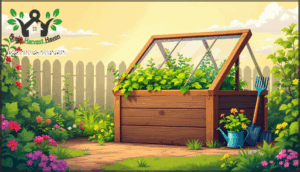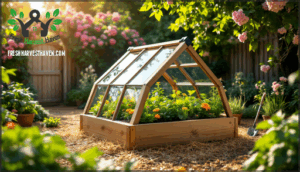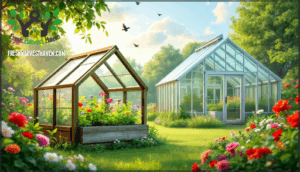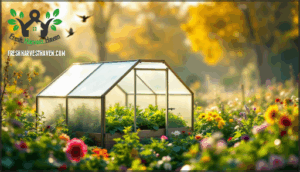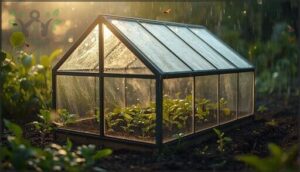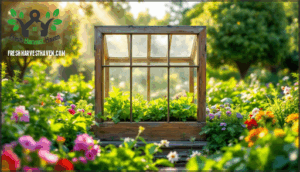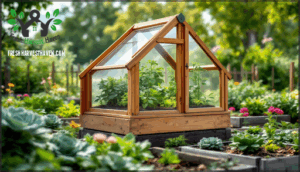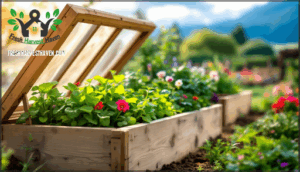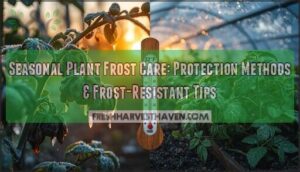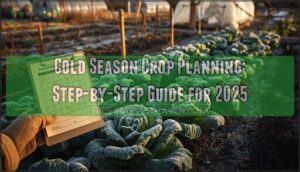This site is supported by our readers. We may earn a commission, at no cost to you, if you purchase through links.
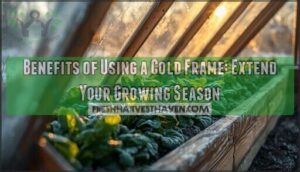
Cold frames trap solar heat during the day and release it slowly at night, creating a microclimate that can run 5 to 20 degrees warmer than the surrounding air. This temperature buffer shields plants from killing frosts, blocks destructive winds, and cuts pest invasions by up to 70 percent.
Whether you’re starting seedlings six weeks earlier or picking lettuce through December, cold frames deliver the benefits of season extension without the cost or complexity of traditional greenhouses.
Table Of Contents
Key Takeaways
- Cold frames create a protective microclimate that raises temperatures 5–20°F above outdoor air, extending your growing season by 4–8 weeks in both spring and fall without electricity or complex equipment.
- These simple structures cut pest invasions by up to 70% and reduce fungal diseases by roughly half, acting as physical barriers that protect plants from wind, rain, heavy snow, and common garden threats.
- You can build a functional cold frame for under $20 using salvaged materials like old windows and scrap lumber, making it a cost-effective alternative to greenhouses that start at $500 or more.
- Cold frames serve multiple purposes year-round—starting seedlings earlier, hardening off transplants to reduce shock by 30%, and keeping hardy crops like kale and root vegetables harvestable through winter months.
What is a Cold Frame?
A cold frame is basically a box with a transparent lid that sits on the ground and captures heat from the sun. Think of it as a mini greenhouse that protects your plants from harsh weather while warming the soil and air inside.
Before you build or buy one, it helps to understand what makes a cold frame work and how it compares to other growing structures.
Definition and Basic Function
A cold frame is basically a bottomless box with a transparent lid that captures sunlight to warm the soil and air inside, creating a protective microclimate for your plants without any need for electricity or complex equipment.
Think of it as a mini greenhouse that sits right on the ground, functioning as a plant shelter that extends your season by trapping solar heat during the day and radiating it back at night, protecting crops from frost, wind, and harsh weather.
Key Components and Materials
Building a cold frame doesn’t require fancy materials—in fact, you can put one together using untreated wood, old storm windows, or even straw bales paired with a transparent lid made from glass, clear plastic, or fiberglass panels.
The key is choosing materials that withstand moisture without rotting, which is why untreated or painted wood works best for cold frame construction.
For the transparent cover, glass offers excellent heat retention, while plastic or doublewall polycarbonate plastic provides durability and lighter weight—your choice depends on budget and how much insulation you need.
How Cold Frames Differ From Greenhouses
While both provide plant protection, the structural differences and climate control capabilities set these two apart. Cold frames are low-profile, passive structures relying on solar warmth—adding 5–20 °F above outdoor temperatures—while greenhouses offer walk-in space with automated heating, ventilation, and year-round growing power.
Frame comparison highlights include:
- Cost efficiency: DIY cold frames start around $20; greenhouses begin at $500-plus
- Season extension: Cold frames add 4–8 weeks; greenhouses enable 12-month production
- Climate control: Cold frames use manual venting; greenhouses feature thermostatic systems
- Structural differences: Cold frames stand 6–10 inches tall; greenhouses reach 7+ feet with shelving
Understanding the cold frame vs options is essential for making an informed decision. Choose cold frames for affordable spring/fall gardening techniques, or greenhouses when controlling every environmental factor matters most.
How Cold Frames Extend The Growing Season
A cold frame acts like a shield between your plants and harsh weather, capturing solar warmth during the day and releasing it slowly through the night. This temperature buffer lets you push past your usual planting and harvest dates by several weeks—or even months.
A cold frame captures solar warmth and shields plants from harsh weather, extending your growing season by several weeks or even months
Here’s how cold frames stretch your growing calendar at both ends of the season.
Frost Protection and Temperature Control
Think of your cold frame as a climate control buffer zone between indoors and harsh outdoor conditions. Frost protection becomes remarkably effective when these structures maintain internal temperatures 5°F to 10°F higher than ambient air.
You’ll notice thermal insulation working hardest during nighttime, when proper temperature monitoring prevents your plants from experiencing damaging cold snaps. Strategic climate regulation through ventilation stops overheating—critical since closed frames can spike past 130°F on sunny days.
This temperature control aids frost tolerance and winter hardening, giving your cold frame genuine season extension power. By utilizing a cold frame design, gardeners can fine-tune their structure for maximum growing efficiency.
Starting Plants Earlier in Spring
You can jump-start your spring garden by a full month when you leverage solar warmth to prepare soil and seedlings weeks before the last frost date. This cold frame advantage transforms early germination from risky gamble to reliable strategy.
Your spring planting timeline gets a powerful boost:
- Cool-season crops like lettuce and spinach can go in 2–4 weeks earlier than standard recommendations
- Seed starting happens directly outdoors, eliminating greenhouse dependency
- Soil temperatures reach ideal ranges (around 45°F) faster inside the frame
- Frost timing becomes less critical as your seedlings develop protected root systems
Season extension through smart gardening means you’re harvesting while neighbors are still planning.
Prolonging Harvests Into Fall and Winter
When the first frost warnings arrive, your cold frame becomes the difference between watching your garden fade and continuing to harvest fresh produce well into December. With proper frost protection, cold-hardy vegetables like kale and carrots thrive through winter.
These fall gardening tips optimize season extension: choose winter crop selection varieties bred for cold weather crops, time your harvest timing before hard freezes, and you’ll be extending the growing season by up to three months using this simple coldfame strategy.
Plant Protection and Improved Growth
Beyond creating a warmer microclimate, cold frames act as physical shields that protect your plants from multiple environmental stresses. They also reduce common problems that plague outdoor gardens, from destructive weather to unwanted visitors.
Let’s look at three key ways cold frames safeguard your plants and promote stronger growth.
Shielding From Wind, Rain, and Snow
A cold frame acts like a sturdy shield for your plants, blocking harsh winds that can snap tender stems and deflecting heavy rain or snow that might otherwise flatten seedlings or waterlog the soil. This windbreak creates a calm microclimate where your crops can grow undisturbed, while the transparent lid provides snow insulation and rain shields without sacrificing sunlight.
With proper weather protection in place, you’ll maintain better temperature control and enjoy protected gardening throughout unpredictable spring and fall conditions.
Preventing Pest and Disease Issues
By enclosing your crops in a semi-sealed structure, you erect biological barriers that slash pest intrusions by up to 70% and cut fungal disease occurrence by roughly half—a breakthrough for organic solutions and plant protection. Combining proper ventilation with soil pasteurization reduces pathogen loads by 60–80%, while integrated pest control methods minimize chemical dependence by up to 70%.
- Fewer emergency interventions: Less than 10% of cold frame crops need urgent pest management yearly, versus 30–40% in open beds.
- Lower disease stress: Damping-off and powdery mildew drop by 60–75%, preserving seedling vigor without heavy fertilization adjustments.
- Sustainable defense: Diatomaceous earth and neem oil manage over 80% of pest scenarios, supporting cold frame sanitation and shielding plant diseases organically.
Enhancing Seedling Hardiness
Gradual exposure to outdoor conditions transforms fragile indoor seedlings into resilient transplants capable of withstanding environmental stresses that would otherwise stunt growth or cause complete crop failure. This gardening technique of incremental adjustment—opening the lid longer each day—builds natural defenses that safeguard season extension goals without compromising seedling protection during critical growth phases.
Your cold frame becomes a training ground for seedling acclimation, where hardening off reduces transplant shock by 30% and strengthens stem tissue through controlled exposure.
Cost-Effective and Sustainable Gardening
Cold frames won’t break the bank, and they’re kinder to the planet than most gardening setups. You can build one from scrap lumber and an old window, or keep things even simpler with bales and salvaged materials.
Here’s how cold frames save you money while cutting your environmental footprint.
Affordable Materials and DIY Options
You don’t need expensive DIY kits to build a functional cold frame. Salvaged materials like recycled wood and repurposed windows work beautifully for coldframe construction and design, often costing under $20 compared to prefabricated options that run $150–$300.
Budget frames built from scrap lumber, old storm glass, or even hay bales deliver the same gardening season extension benefits while giving you complete control over dimensions and features for your Cold Frame Gardening setup.
Energy Efficiency and No External Power
Beyond the low upfront costs, your cold frame runs entirely on free solar energy—no electricity bills, no heaters to wire, and no ongoing power consumption to factor into your gardening budget.
Passive heating through solar gain warms the air and soil, while thermal mass from the ground holds warmth overnight.
This energy conservation approach delivers season extension with zero carbon footprint—just smart insulation and natural temperature control.
Lower Maintenance Compared to Greenhouses
Since your cold frame doesn’t plug into anything, there’s almost nothing to go wrong—no filters to change, no fans to replace, and no complex systems demanding your attention every week. Simple ventilation means propping open the lid when temperatures climb. That’s it.
- Easy construction with basic materials keeps cold frame upkeep minimal
- Reduced labor compared to managing greenhouse climate controls
- Low costs for repairs—just occasional hinge adjustments or lid cleaning
- Minimal upkeep lets you focus on plants, not gardening structures maintenance
Versatile Uses for Cold Frames
Cold frames aren’t just for one season or one purpose—they’re adaptable structures that work hard throughout the year. Whether you’re pushing the limits of your growing calendar, strengthening young plants, or keeping harvests accessible through winter, a cold frame adjusts to what you need.
Here are three practical ways you can put a cold frame to work in your garden.
Growing Cool-Season Vegetables
Your cold frame creates the perfect conditions for cool-season crops like lettuce, spinach, and radishes. These hardy vegetables thrive in temperatures between 40°F and 80°F, even when outdoor conditions drop below freezing.
You can plant spinach and arugula up to three weeks earlier than unprotected beds, since the frame warms soil faster in late winter. Sequential sowings from August through March let you harvest fresh greens continuously, with some gardeners maintaining yields into deep winter under proper management.
Hardening Off Seedlings and Transplants
Once your seedlings have sprouted indoors under grow lights or on sunny windowsills, you’ll need to toughen them up before planting them directly into your garden beds. Gradual hardening through your cold frame prevents transplant shock by slowly acclimating tender plants to outdoor exposure.
Over seven to ten days, increase ventilation progressively:
- Open the lid slightly for two hours on day one
- Extend exposure by one hour daily as plants adapt
- Monitor for wilting during seasonal change periods
This controlled process strengthens cell walls and reduces stress when you finally transplant.
Overwintering Plants and Root Crops
Your cold frame becomes a protective shield for hardy crops that would otherwise sit idle in frozen soil, turning winter’s harsh grip into a manageable inconvenience. Carrots, beets, and parsnips remain accessible through deep frosts when you pack straw around the frame for cold frame insulation.
Select cold-hardy vegetables with strong frost tolerance—kale, spinach, and winter lettuce—for reliable season extension. Root crops stay fresh and firm, protected from rot while you harvest on your schedule.
Tips for Maximizing Cold Frame Benefits
Getting the most from your cold frame isn’t just about building it—it’s about managing it smartly. A few straightforward adjustments to placement, airflow, and insulation can make the difference between a basic season extender and a high-performing plant shelter.
Here’s what you need to focus on to keep your cold frame working at its best.
Ideal Placement and Sun Exposure
Choosing the right spot for your cold frame can mean the difference between sluggish seedlings and thriving plants ready to take on the season. Site selection matters—aim for southern exposure to capture maximum sunlight hours throughout the day.
This frame orientation warms your soil faster and gives you better temperature control, especially in cooler climates. Position your cold frame in a sheltered garden area where it can soak up at least six hours of sun.
Ventilation and Temperature Management
Without proper ventilation, even a well-placed cold frame can quickly turn into an overheated trap that wilts your plants instead of protecting them. Open the lid when internal temperatures push past 70°F—you’ll maintain air circulation and prevent heat buildup.
Automatic ventilation systems take the guesswork out of temperature control, while adding thermal mass like water jugs helps stabilize climate control and improve heat retention overnight for better season extension.
Insulation and Seasonal Adjustments
As seasons shift, so should your cold frame setup—straw bales and bubble wrap become your best friends when frost threatens, while leaf mulch and loosened lids keep things balanced through milder spells. Adjust your frame insulation and weatherproofing to match changing conditions:
- Pack straw or leaves around walls for added thermal mass in winter
- Apply seasonal covers like row fabric during extreme cold snaps
- Remove excess insulation in spring to prevent overheating
- Monitor temperature control weekly as daylight hours shift
Smart adjustments mean better season extension and healthier plants year-round.
Frequently Asked Questions (FAQs)
What soil mix works best for cold frames?
Think of soil as the foundation of a house—get it right, and everything thrives. You’ll want a balanced mix with equal parts compost, garden soil, and coarse sand or perlite to guarantee proper drainage and nutrient balance.
This composition assists healthy seedlings while maintaining ideal pH levels between 0 and
Can cold frames protect against heavy snow loads?
Most cold frames aren’t built for heavy snow loads—standard designs can buckle under deep accumulation. Snow management is critical for winter protection: reinforce your cold frame design with angled lids to shed snow, use sturdy materials like thick lumber, and brush off buildup regularly to maintain frame durability and effective climate control.
How do you prevent condensation and excess moisture?
Ironically, the very warmth that protects your plants can drown them if moisture accumulates unchecked. Open your cold frame lid daily when temperatures climb above 70°F to release humid air and boost circulation. Tilt covers slightly on milder days to create airflow without exposing plants to harsh winds.
Secure proper drainage by sloping the soil bed slightly or adding gravel beneath planting areas. Wipe condensation from transparent surfaces each morning to prevent water droplets from magnifying sunlight and scorching tender leaves below.
Which crops should not be grown in cold frames?
Tropical plants and heat-loving vegetables don’t belong in cold frames. These structures excel at protecting cool-season crops but won’t support the high temperatures needed for peppers, tomatoes, cucumbers, or melons.
Avoid high-maintenance tropical blooms—they’ll struggle without consistent warmth.
When should you close the lid at night?
Sunset signals the time for nighttime closure, but don’t rush—wait until temperatures drop near 40°F.
Your cold frame needs lid management for frost prevention, safeguarding plant protection and climate control.
Adjust seasonal timing as spring warms or fall cools.
Conclusion
Cold frames demand little but deliver much: lower costs, fewer pests, and longer harvests. They extend your reach into seasons once thought impossible, turning frozen ground into productive space.
They harden seedlings without electricity, protect crops without chemicals, and reward patience with fresh greens when neighbors scrape ice. The benefits of using a cold frame aren’t just practical—they’re life-changing.
With scrap wood and clear lids, you’re not just gardening; you’re mastering the rhythm of seasons and claiming time others consider lost.

